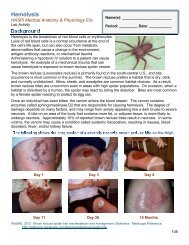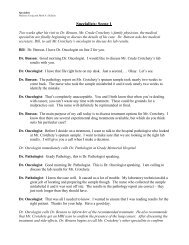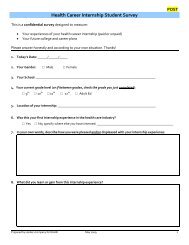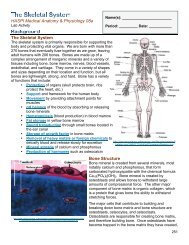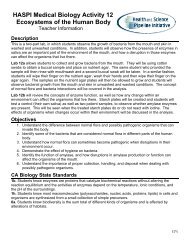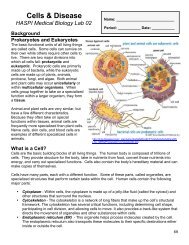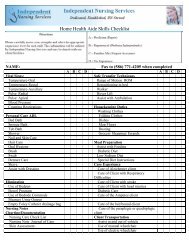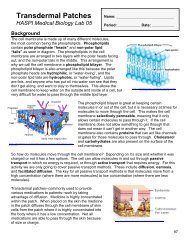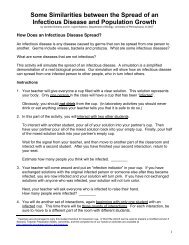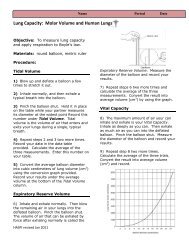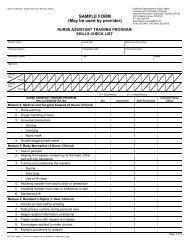Combinatorial Chemistry and Drug Discovery Lab Jasmine ... - haspi
Combinatorial Chemistry and Drug Discovery Lab Jasmine ... - haspi
Combinatorial Chemistry and Drug Discovery Lab Jasmine ... - haspi
Create successful ePaper yourself
Turn your PDF publications into a flip-book with our unique Google optimized e-Paper software.
<strong>Combinatorial</strong><br />
<strong>Chemistry</strong> <strong>and</strong> <strong>Drug</strong><br />
<strong>Discovery</strong> <strong>Lab</strong><br />
<strong>Jasmine</strong> Erfe Miramar College/<strong>Lab</strong> Technician<br />
Ericka Senegar-Mitchell Science in the City/<br />
Director; Junipero Serra High School/Science Educator<br />
S<strong>and</strong>ra Slivka Southern CA Biotechnology Center @<br />
Miramar College/Director
Background<br />
This lab protocol was<br />
adapted from the original<br />
work of Scott Wolkenberg<br />
<strong>and</strong> Andrew Su of The<br />
Scripps Research Institute<br />
in La Jolla, California. The<br />
experiment was originally<br />
published in the June 2001<br />
issue of the Journal of<br />
Chemical Education <strong>and</strong><br />
implemented in the San<br />
Diego area from May 2002<br />
thru 2005.<br />
CITATION:<br />
Wolkenberg, Scott E.; Su, Andrew I. J Chem.Educ.<br />
2001 78 784
Overview<br />
• In this lab students will identify a drug that<br />
kills bacteria by producing libraries of<br />
compounds based on the A-B model.<br />
• They will test the mixtures for antibiotic<br />
activity <strong>and</strong> then isolate the individual<br />
compound(s) which possess antibiotic<br />
properties.<br />
• Students t will screen the mixtures by utilizing<br />
i<br />
techniques used to conduct Kirby-Bauer <strong>and</strong><br />
Ouchterlony tests.<br />
t
California<br />
Science Content<br />
St<strong>and</strong>ards<br />
Subject Area<br />
Content St<strong>and</strong>ard<br />
<strong>Chemistry</strong><br />
Biology<br />
Genetics (Molecular Biology)<br />
Genetics (Biotechnology)<br />
Evolution<br />
Physiology<br />
2.a. Chemical Bonds – formation of ionic <strong>and</strong> covalent (peptide) bonds<br />
3.g. Stoichiometry – redox reactions, dehydration synthesis (condensation)<br />
10.b. Organic <strong>Chemistry</strong> – bonding characteristics of carbon<br />
10.e. Functional Groups – formation of a hydrazone from an aldehyde d <strong>and</strong> a<br />
hydrazine, identification <strong>and</strong> analysis of amine groups<br />
1.a. Membrane Regulation – membrane structure <strong>and</strong> function<br />
1.c. Prokaryotic <strong>and</strong> Eukaryotic Cells – structure <strong>and</strong> function<br />
1.h. Macromolecules – structure <strong>and</strong> function<br />
4.c. Mutations – antibiotic expression<br />
4.e. Proteins – structure<br />
4.f. Proteins – function/chemical properties<br />
5.c. Biotechnology – production of novel biomedical <strong>and</strong> agricultural<br />
products<br />
7.a. Natural Selection – phenotype vs. genotype<br />
7.d. Genetic Variation – influence of environmental factors on the natural<br />
selection of adaptive traits<br />
8.a. Natural Selection – selective fitness; differential survival of groups<br />
10.b. Immune Response – antibody/antigen response<br />
10.d. Bacterial Infections – use of antibiotics in treating bacterial infections;<br />
use of antibacterial agents to control the growth of bacteria
National<br />
Science Education<br />
St<strong>and</strong>ards<br />
Category<br />
Content St<strong>and</strong>ard<br />
Unifying Concepts <strong>and</strong> Processes<br />
Science as Inquiry<br />
Life Science<br />
Science <strong>and</strong> Technology<br />
Science in Personal <strong>and</strong> Social<br />
Perspectives<br />
History <strong>and</strong> Nature of Science<br />
Change, constancy <strong>and</strong> measurement – process of generating chemical<br />
libraries <strong>and</strong> screening for effective compounds, combinatorial data<br />
Evidence, models, <strong>and</strong> explanation – Kirby-Bauer & Ouchterlony Tests<br />
Form <strong>and</strong> dfunction –cells, macromolecules, l prokaryotes (E.coli )<br />
Abilities necessary to do scientific inquiry – production of mixtures<br />
(libraries) of compounds using the A-B model; deconvolution (separation)<br />
of the mixtures to identify the compound(s) with antibiotic properties<br />
The Cell<br />
– types of cells, cell membrane structure <strong>and</strong> function<br />
Biological evolution – development of antibiotic resistance<br />
Behavior of organisms – growing bacterial cultures (lag vs. log phase),<br />
interpretation of bacterial plates (deconvolution)<br />
Underst<strong>and</strong>ings about science <strong>and</strong> technology – process <strong>and</strong> design in<br />
combinatorial chemistry; bringing a new pharmaceutical to market<br />
Personal <strong>and</strong> community health – drug discovery, pharmacology,<br />
diagnosis of human disease <strong>and</strong> course of treatment<br />
Natural <strong>and</strong> human-induced hazards – aseptic (sterile) technique,<br />
safety protocols including Material Safety Data Sheets (MSDS)<br />
Science as a human endeavor – biomedical research, clinical trials,<br />
bioethics of the biotechnology industry
Chemicals
Chemicals<br />
CHEMICAL VENDOR CATALOG # PRICE*<br />
A1: 2-nitrobenzaldehyde Sigma-Aldrich 772780-50g $116.50<br />
A2: 5-nitro-2-furaldehyde Sigma-Aldrich 170968-25g $102.50<br />
A3: 3-nitrobenzaldehyde Sigma-Aldrich<br />
B1: 4-bromophenylhydrazine<br />
hydrochloride<br />
Sigma-Aldrich 143219-10g $101.50<br />
B2: 4-cyanophenylhydrazine<br />
hydrochloride<br />
Sigma-Aldrich 453471-5g $42.20<br />
B3: aminoguanidine bicarbonate Sigma-Aldrich<br />
N10845-<br />
100g $17.80<br />
109266-<br />
100g<br />
$15.00<br />
Total: $395.50<br />
50
Suggested Materials
Presenter Notes<br />
Preparing Overnight Culture of E. coli<br />
1. Transfer 10ml of sterile LB broth in a culture tube.<br />
2. To obtain a sample of E.coli, take the inoculating loop <strong>and</strong> dip into the frozen E. coli<br />
stock. Be certain that some of the stock has adhered to the loop.<br />
3. Dip the inoculating loop into the culture tube containing the 10ml of LB broth. Stir the<br />
broth using the loop to ensure that the E. coli is thoroughly mixed in the broth.<br />
4. Cap the tube <strong>and</strong> incubate the E. coli culture overnight at 37°C with agitation.
Presenter Notes<br />
Growing E. Coli into Log Phase<br />
1. Transfer 25ml of sterile LB broth in a 50ml Erlenmeyer flask.<br />
2. Take 1ml of the prepared overnight E. coli culture <strong>and</strong> transfer the<br />
sample into the Erlenmeyer flask containing 25ml of LB broth.<br />
3. Cap the Erlenmeyer flask <strong>and</strong> incubate at 37°C with agitation.<br />
ti
Presenter Notes<br />
Spectrophotometer<br />
1. Turn on the spectrophotometer <strong>and</strong> set to O.D. 550.<br />
2. Take a 3ml sample of the E. coli culture <strong>and</strong> transfer into a test tube. Wipe <strong>and</strong> h<strong>and</strong>le the<br />
test tube with Kimwipes <strong>and</strong> place into the spectrophotometer.<br />
3. Note the reading. The culture will reach log phase once the O.D. 550 reaches 0.3-0.4.<br />
4. If the reading has not reached log phase, repeat steps 2 <strong>and</strong> 3 using a clean test tube<br />
<strong>and</strong> waiting 30 minutes between each new reading.<br />
5. Once the culture has reached log phase, note the total volume of culture that remains in<br />
the flask. According to the volume, add glycerol in the amount of 15% of the total volume<br />
to the flask <strong>and</strong> immediately transfer 1 ml aliquots of the log phase culture into cryogenic<br />
tubes <strong>and</strong> freeze at -80ºC.
Instructor Notes<br />
Prepare stock solutions<br />
You have been provided 6 uniquely labeled conical tubes, each<br />
containing i a specific chemical. Add 12 mL of deionized i d water to<br />
each tube <strong>and</strong> shake vigorously for approximately ten seconds.
Instructor Notes<br />
If mixtures are not completely dissolving<br />
using a hot water bath may be effective.
<strong>Combinatorial</strong><br />
<strong>Chemistry</strong> <strong>and</strong> <strong>Drug</strong><br />
<strong>Discovery</strong> <strong>Lab</strong><br />
Student Protocol
Tips for h<strong>and</strong>ling E.coli:<br />
<strong>Lab</strong> Safety<br />
1. Wipe down the lab bench or station with a 10% bleach solution or 70%<br />
isopropanol solution at the beginning <strong>and</strong> end of each laboratory session.<br />
2. When creating mixtures <strong>and</strong> transferring chemical solutions or liquid bacterial<br />
cultures, keep nose <strong>and</strong> mouth away from the opening of the tube to avoid<br />
inhaling any aerosols that may be created.<br />
3. All spills should be reported to your instructor <strong>and</strong> cleaned up immediately<br />
according to the Material Safety Data Sheets (MSDS) for each chemical used in<br />
the experiment. Be sure to wear proper footwear (closed toe) to prevent injury.<br />
4. Dispose of any materials that have come in contact with bacterial cultures (i.e.<br />
tubes, pipettes) in special waste containers as provided d by your instructor.<br />
t<br />
5. Wash h<strong>and</strong>s with soap <strong>and</strong> water before leaving the lab.
Overview<br />
• This lab protocol was adapted<br />
from the original work of Scott<br />
Wolkenberg <strong>and</strong> Andrew Su of<br />
The Scripps Research Institute<br />
in La Jolla, CA. The experiment<br />
was originally published in the<br />
June 2001 issue of the Journal of<br />
Chemical Education.<br />
• <strong>Combinatorial</strong> <strong>Chemistry</strong> is a<br />
technique used to synthesize a<br />
library of compounds <strong>and</strong> screen<br />
for a desired property. Instead of<br />
screening one compound at a<br />
time, the compounds are<br />
screened more efficiently in<br />
mixtures.<br />
CITATION:<br />
Wolkenberg, Scott E.; Su, Andrew I. J Chem. Educ. 2001 78 784
During the<br />
EXPONENTIAL or LOG<br />
PHASE bacteria are<br />
growing <strong>and</strong> dividing<br />
at the maximal rate<br />
given their genetic<br />
potential, nature of the<br />
medium <strong>and</strong> conditions<br />
under which they are<br />
growing.<br />
In the STATIONARY<br />
PHASE, the total number<br />
of viable bacteria<br />
a<br />
remains constant. This<br />
may result from a<br />
balance between cell<br />
division <strong>and</strong> cell death or<br />
cells may cease to divide<br />
while remaining<br />
metabolically active.<br />
When microorganisms are<br />
introduced into fresh culture<br />
medium usually no immediate<br />
increase in cell number occurs<br />
therefore this is referred to as<br />
the LAG PHASE.<br />
Detrimental environmental<br />
conditions such as lack of<br />
nutrients <strong>and</strong> waste buildup<br />
lead to the decline, usually<br />
logarithmic, in the number of<br />
viable cells. This is characteristic<br />
of the DEATH PHASE.<br />
What limiting factors would cause a microbial<br />
population to enter the stationary phase?
•Disk-diffusion method used<br />
for routine testing in a clinical<br />
laboratory in which an isolated<br />
microbe is tested t for<br />
susceptibility to numerous<br />
antibiotics.<br />
Kirby-Bauer<br />
Test<br />
•The isolated organism is<br />
uniformly placed on an agar<br />
plate with paper disk of fixed<br />
concentrations of antibiotics.<br />
•Growth of the organism <strong>and</strong><br />
diffusion of the antibiotic<br />
occur simultaneously resulting<br />
in a circular zone of inhibition<br />
if the antibiotic has<br />
antibacterial properties.<br />
Measuring Antibiotic<br />
Resistance
Ouchterlony Test<br />
•A double diffusion technique developed by Organ<br />
Ouchterlony more than 40 years ago.<br />
•AA technique in which reaction partners, antigen <strong>and</strong><br />
antibody, are allowed to diffuse to each other in an agar<br />
gel in a precipitation reaction.<br />
•Classical procedure used to detect the presence of<br />
antibodies <strong>and</strong> determine their specificity by<br />
visualization of "lines of identity" or precipitin lines.
Student/Group <strong>Lab</strong> Set-up<br />
3 Luria Broth (LB) agar plates<br />
6, 15mL conical tubes<br />
containing stock solutions:<br />
•A1: 2-nitrobenzaldehyde<br />
•A2: 5-nitro-2-furaldehyde<br />
•A3: 3-nitrobenzaldehyde<br />
•B1: 4-bromophenylhydrazine hydrochloride<br />
•B2: 4-cyanophenylhydrazine hydrochloride<br />
•B3: aminoguanidine bicarbonate<br />
1 cryotube (orange cap)<br />
containing 1.0 mL E. coli<br />
1 cell spreader<br />
15 disposable transfer<br />
pipettes or P-1000 micropipette<br />
9 eppendorf tubes<br />
1 plastic straw, wrapped<br />
1 sterile wrapped transfer pipette<br />
Conical i l tube rack<br />
Sharpie Marker
<strong>Lab</strong>el transfer pipettes<br />
1. <strong>Lab</strong>el 6 of the transfer pipettes A1, A2, A3, B1, B2, B3. These will be used to<br />
prepare your compounds.<br />
2. <strong>Lab</strong>el 9 transfer pipettes M1, M2, M3, M4, M5, M6, A#B1, A#B2, A#B3. These<br />
will be used to transfer your compounds onto the plates. Each student or<br />
group will be assigned mixtures to test for confirmation of antibiotic<br />
activity (i.e. # = 1, 2, or 3 for A1B1, A1B2, A1B3; A2B2… ).
<strong>Lab</strong>el epitubes
<strong>Lab</strong>el Petri dishes<br />
M1 M2<br />
M4 M5<br />
A#B1 A#B2<br />
M3<br />
M6<br />
A#B3<br />
Each student or group will be<br />
assigned mixtures to test for<br />
confirmation of antibiotic activity.<br />
(i.e. # = 1, 2, or 3 for A1B1, A1B2,<br />
A1B3; A2B2...).<br />
M1 M2 M4 M5 A#B1 A#B2<br />
M3 M6 A#B3<br />
Create wells in plates
Carefully invert the tube containing i 10<br />
1.0<br />
ml of thawed E. coli several times before<br />
opening. Spread the E. coli culture evenly<br />
on the surface of each agar plate.
Prepare mixtures<br />
(libraries)<br />
1. Make sure that the<br />
proper transfer pipette is<br />
used for each solution to<br />
avoid contamination.<br />
2. Add solutions in the<br />
order indicated in the table.<br />
Record your observations.<br />
Tube # Add 5 drops Then 5 drops<br />
Then 5<br />
drops<br />
Then 15 drops<br />
M1 B1 B2 B3 A1<br />
M2 B1 B2 B3 A2<br />
NOTE:<br />
15 drops = ~ 750µL<br />
5 drops = ~ 250µL<br />
1 drop = .05 mL = 50 µL<br />
M3 B1 B2 B3 A3<br />
M4 A1 A2 A3 B1<br />
M5 A1 A2 A3 B2<br />
M6 A1 A2 A3 B3
Add compounds to wells <strong>and</strong><br />
wait approximately 15-20<br />
minutes for liquid to absorb.
Incubate at 37ºC or store at<br />
room temperature overnight.<br />
(48 hours is optimal for room temperature<br />
option)<br />
1. If no incubator is<br />
available: Plates can<br />
be stored overnight at<br />
room temp. with the<br />
agar side down.<br />
2. If incubator is available:<br />
Allow compounds to<br />
absorb into agar then<br />
incubate agar side up.
Chemical Structures<br />
A carbonyl group<br />
at the end of the<br />
carbon skeleton<br />
indicates that the<br />
compound is an<br />
ALDEHYDE<br />
The amino group<br />
(-NH 2 ) consists of<br />
a nitrogen atom<br />
bonded dto two<br />
hydrogen atoms;<br />
the compound is<br />
a HYDRAZINE<br />
Wolkenberg, Scott E.; Su, Andrew I. J Chem. Educ. 2001 78 784
Chemical Structures of<br />
Synthesized Compounds<br />
A special type of<br />
covalent bond called a<br />
peptide bond forms<br />
between the carbon<br />
<strong>and</strong> the nitrogen<br />
creating a newly<br />
synthesized<br />
compound called a<br />
HYDRAZONE.<br />
The oxygen from the carbonyl<br />
group of the aldehyde leaves<br />
to bond with the hydrogen<br />
from the amino group of the<br />
hydrazine to form water. This<br />
represents a condensation<br />
reaction or dehydration<br />
synthesis.<br />
A-B Model<br />
Wolkenberg, Scott E.; Su, Andrew I. J Chem. Educ. 2001 78 784
<strong>Combinatorial</strong><br />
<strong>Chemistry</strong> <strong>and</strong> <strong>Drug</strong><br />
<strong>Discovery</strong> <strong>Lab</strong><br />
Data Analysis/<br />
Results
Data Analysis<br />
- + = no inhibition of growth = zone of inhibition of growth<br />
Mixture Contents Result<br />
M1<br />
A1, B1, B2, B3<br />
-<br />
M2<br />
A2, B1, B2, B3<br />
+<br />
-<br />
M3<br />
A3, B1, B2, B3<br />
M4 B1, A1, A2, A3 -<br />
M5<br />
B2, A1, A2, A3<br />
-<br />
+<br />
M6 B3, A1, A2, A3
Data Analysis<br />
Mixtures<br />
(Libraries) M1 M2 M3<br />
M4<br />
A1-B1<br />
A2-B1<br />
A3-B1<br />
M5<br />
A1-B2 A2-B2 A3-B2<br />
M6 A1-B3 A2-B3 A3-B3<br />
Using this table, we can determine which compound in<br />
our active mixtures has antibiotic properties. First,<br />
shade in the column to indicate the mixture that shows<br />
antibiotic activity for compounds M1 thru M3. Next,<br />
shade in the row that corresponds to the mixture M4<br />
thru M6 that shows antibiotic activity. The position in<br />
the table where the shaded column <strong>and</strong> shaded<br />
row intersect is the active compound.
Extension: Kirby–Bauer Test<br />
Determining Class Average Zone Size<br />
1. After 24 hours in the incubator or 48 hours at room temperature check for the<br />
presence of antibiotic activity. This is done by looking for a clear area, called a<br />
zone of inhibition, surrounding a well. Remember to never open the Petri dish<br />
for a better view. Use the agar side to observe <strong>and</strong> measure any zone of<br />
inhibition.<br />
2. Using a ruler, measure the diameter (in millimeters) of any zone of inhibition <strong>and</strong><br />
record your individual group data on the data table provided.<br />
3. Now gather class data to determine the average zones of inhibition, if present,<br />
for each of the different compounds M1 thru M6 <strong>and</strong> record the averages.<br />
4. After recording the average class data for the diameters of the zones of<br />
inhibition, decide whether your groups sample of E.coli bacteria is susceptible<br />
(sensitive) displaying a CLEAR zone of inhibition, unaffected (resistant)<br />
showing no observable zone of inhibition or intermediate (somewhere in<br />
between) ee for each of the compounds M1 thru M6. Record your conclusion c o in the<br />
final column of the data table.
Extension: Kirby–Bauer Test<br />
Determining Class Average Zone Size<br />
Using a ruler measure the diameter (in millimeters) of any zone of inhibition<br />
Using a ruler, measure the diameter (in millimeters) of any zone of inhibition<br />
<strong>and</strong> record your individual group data on the data table provided.
Extension: Zone Size Interpretive Chart<br />
ANTIMICROBIAL<br />
AGENT<br />
DISC CODE<br />
R = mm<br />
or less<br />
I = mm<br />
range<br />
MS =<br />
S = mm<br />
or more<br />
amoxicillin (Staph) AMC 19 20<br />
amoxicillin (other<br />
bacteria)<br />
AMC 13 14‐17 18<br />
Concept Review<br />
ampicillin (Staph) AM 28 29<br />
ampicillin (other<br />
AM 11 12‐13 14<br />
Suggest bacteria) a reason why groups may have reported<br />
carbenicillin<br />
different diameters CB for 13 the zones 14‐16 of inhibition 17<br />
(Pseudomonas)<br />
created carbenicillin (other in response to the six compounds tested.<br />
CB 17 18‐22 23<br />
bacteria)<br />
Why do you suppose most antibiotics are allowed a<br />
cefoxatime CTX 14 15‐22 23<br />
cephalothin<br />
range of diameters<br />
CF<br />
for<br />
14their zones<br />
15‐17<br />
of inhibition on<br />
18<br />
chloramphenicol C 12 13‐17 18<br />
the SIR table?<br />
erythromycin E 13 14‐22 23<br />
gentamycin GM 12 13‐14 15<br />
methicillin (used<br />
for Staph only)<br />
M (or DP) 9 10‐1313 14<br />
penicillin P 28 29<br />
streptomycin S 11 12‐14 15<br />
sulfamethoxazole‐<br />
l<br />
trimethoprim<br />
SXT‐TMP 10 11‐15 16<br />
tetracycline TE 14 15‐18 19
Expected Results at 37ºC
Results at Room Temperature
Chemical Structure of the<br />
Active Compound<br />
5-nitro-2-furaldehyde<br />
d<br />
aminoguanidine bicarbonate<br />
One of the resulting compounds created in our library of<br />
mixtures is “discovered” to have antibacterial properties. The<br />
active compound is a known antibiotic called guanofuracin<br />
which was discovered in the 1950’s <strong>and</strong> developed for both<br />
human <strong>and</strong> veterinary use.
<strong>Combinatorial</strong><br />
<strong>Chemistry</strong> <strong>and</strong> <strong>Drug</strong><br />
<strong>Discovery</strong> <strong>Lab</strong><br />
Post-lab<br />
Discussion
Autoclaving is the most<br />
effective <strong>and</strong> most efficient<br />
means of sterilization. All<br />
autoclaves operate on a time/<br />
temperature relationship. The<br />
usual st<strong>and</strong>ard temperature/<br />
pressure employed is 121ºC/15<br />
psi for 15 minutes.<br />
Antibacterial<br />
Agents
Three Major Classes of<br />
Antibacterial Agents<br />
Controlling the growth of microorganims usually<br />
involves the use of physical or chemical agents which<br />
either kill or prevent the growth of microorganisms.<br />
1) Bactericidal – agents that kill bacteria are called cidal<br />
agents; also referred to as bactericides.<br />
2) Bacteriostatic – agents which inhibit the growth of cells<br />
(without killing them) are referred to as static agents.<br />
3) Bacteriolytic – agents that have the ability to lyse or<br />
break apart, dissolve, <strong>and</strong> destroy bacteria by the use of an<br />
enzyme or other agent.<br />
Bacteria have the ability to develop resistance following<br />
repeated or subclinical (insufficient) doses, so more<br />
advanced antibiotics <strong>and</strong> synthetic antimicrobials are<br />
continually required to overcome them.
Gram – positive<br />
bacteria<br />
Variations in bacterial cell wall structures not only cause<br />
differences in staining i but the anatomy of each cell wall also<br />
leads to differences in the susceptibility of bacteria to antibiotics.<br />
Some antibiotics easily penetrate Gram-positive cell walls while<br />
others are more capable of penetrating Gram-negative cell walls.<br />
Gram – negative<br />
bacteria
Antibacterial Sites of Action
Concept Review<br />
• Analyze the graph by<br />
describing the phase of<br />
growth being represented<br />
by lines A thru E: LAG, LOG,<br />
STATIONARY, or DEATH.<br />
• If the graph shown is the<br />
result of antibiotic resistance<br />
testing, what is the effect of<br />
the antibiotics on the growth<br />
of the bacteria at A thru E:<br />
NORMAL, BACTERIOSTATIC,<br />
RESISTANT or BACTERICIDAL?
Great Job <strong>Jasmine</strong> Erfe!



